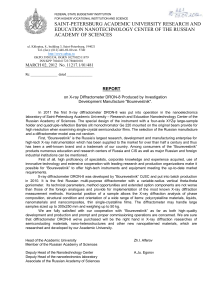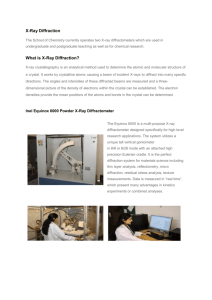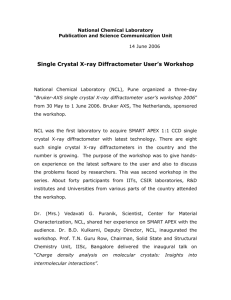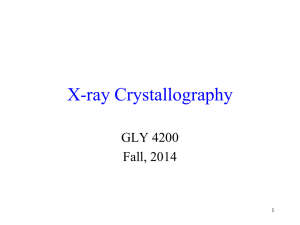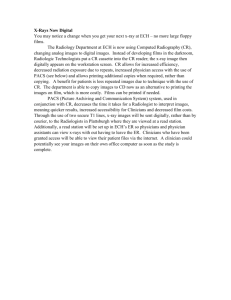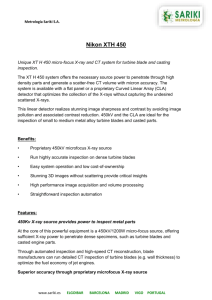X-ray Diffractometry
advertisement
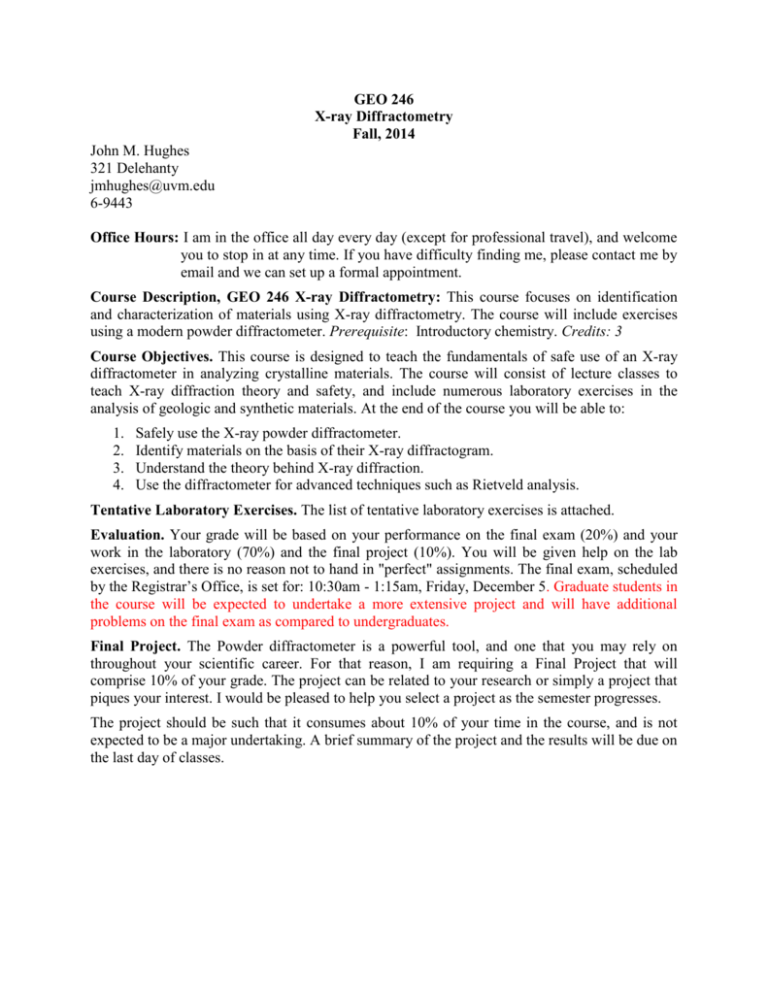
GEO 246 X-ray Diffractometry Fall, 2014 John M. Hughes 321 Delehanty jmhughes@uvm.edu 6-9443 Office Hours: I am in the office all day every day (except for professional travel), and welcome you to stop in at any time. If you have difficulty finding me, please contact me by email and we can set up a formal appointment. Course Description, GEO 246 X-ray Diffractometry: This course focuses on identification and characterization of materials using X-ray diffractometry. The course will include exercises using a modern powder diffractometer. Prerequisite: Introductory chemistry. Credits: 3 Course Objectives. This course is designed to teach the fundamentals of safe use of an X-ray diffractometer in analyzing crystalline materials. The course will consist of lecture classes to teach X-ray diffraction theory and safety, and include numerous laboratory exercises in the analysis of geologic and synthetic materials. At the end of the course you will be able to: 1. 2. 3. 4. Safely use the X-ray powder diffractometer. Identify materials on the basis of their X-ray diffractogram. Understand the theory behind X-ray diffraction. Use the diffractometer for advanced techniques such as Rietveld analysis. Tentative Laboratory Exercises. The list of tentative laboratory exercises is attached. Evaluation. Your grade will be based on your performance on the final exam (20%) and your work in the laboratory (70%) and the final project (10%). You will be given help on the lab exercises, and there is no reason not to hand in "perfect" assignments. The final exam, scheduled by the Registrar’s Office, is set for: 10:30am - 1:15am, Friday, December 5. Graduate students in the course will be expected to undertake a more extensive project and will have additional problems on the final exam as compared to undergraduates. Final Project. The Powder diffractometer is a powerful tool, and one that you may rely on throughout your scientific career. For that reason, I am requiring a Final Project that will comprise 10% of your grade. The project can be related to your research or simply a project that piques your interest. I would be pleased to help you select a project as the semester progresses. The project should be such that it consumes about 10% of your time in the course, and is not expected to be a major undertaking. A brief summary of the project and the results will be due on the last day of classes. Tentative Lecture Schedule 8/26…………. The powder diffractometer; Characteristics of X-rays 8/28…………. X-ray Safety; Radiation Safety Training by the Office of Radiation Safety 9/2, 9/4, 9/9, 9/11…….The powder diffractometer; Characteristics of X-rays; 9/18, 9/18, 9/23………….Bragg’s Law and scattering 9/25, 9/30, 10/2…….…... Crystallography review; space group determination using X-rays 10/7, 10/9, 10/14.... Absorption of X-radiation 10/16, 10/21….GSA 10/23, 10/28.…The structure factor and calculation of X-ray intensities; systematic absences 10/30, 11/4, 11/6….…Solution of crystal structures [Note: I will be out of town for GSA; we will plan around those dates.] 11/11, 11/13….. Rietveld analysis of mixed materials and structure determination by PXRD 11/18……..…... Rietveld analysis of mixed materials and structure determination by PXRD 11/20..…........... Feldspar structural state THANKSGIVING RECESS 12/2…………. Summary Readings: Readings will be assigned from American Mineralogist, which are available on-line with open access at: http://www.minsocam.org/MSA/AmMin/TOC/ In addition, readings will be assigned principally from two books, and they will be available for use in the X-ray laboratory. If access to them becomes difficult, I will purchase another copy of each. The books are: Elements of X-ray Diffraction, B. D. Cullity and S. R. Stock, 3rd Edition (2001). X-rays, Electrons and Analytical Chemistry: Spectrochemical Analysis with X-rays, H. A. Liebhafsky, H. G. Pfeiffer, E. H. Winslow, P. D. Zemany and S. Liebhafsky, Wiley-Interscience, New York, 1972, p. 290.
